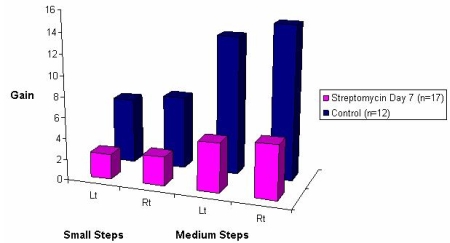The loss of vestibular function can seriously impair one's quality of life and ability to work productively. Functional vestibular loss occurs as the result of disease, exposure to ototoxic medication (e.g., aminoglycoside antibiotics or chemotherapeutic agents), or with age. In collaboration with Dr. Raphael's lab, we are developing a guinea pig model of vestibular function to study eye-head coordination and the neurophysiology of vestibular reflexes, regeneration of sensory function and therapeutic interventions to minimize or prevent vestibular loss due to ototoxicity. The figure below shows how the VOR and VCR synergistically stabilize eye position in space. Either reflex alone may stabilize eye position (panels A and B) or they may each contribute (panel C).
 The next figure compares the amplitude of the vestibulo-collic reflex (VCR) in guinea pigs exposed to streptomycin (pink bars), an ototoxic antibiotic, with normal control guinea pigs (dark bars). In both figures, vestibular reflexes were provoked by rapidly and briefly accelerating the guinea pig about an earth vertical axis to a constant velocity toward the left (Lt) or right (Rt).
The next figure compares the amplitude of the vestibulo-collic reflex (VCR) in guinea pigs exposed to streptomycin (pink bars), an ototoxic antibiotic, with normal control guinea pigs (dark bars). In both figures, vestibular reflexes were provoked by rapidly and briefly accelerating the guinea pig about an earth vertical axis to a constant velocity toward the left (Lt) or right (Rt).


